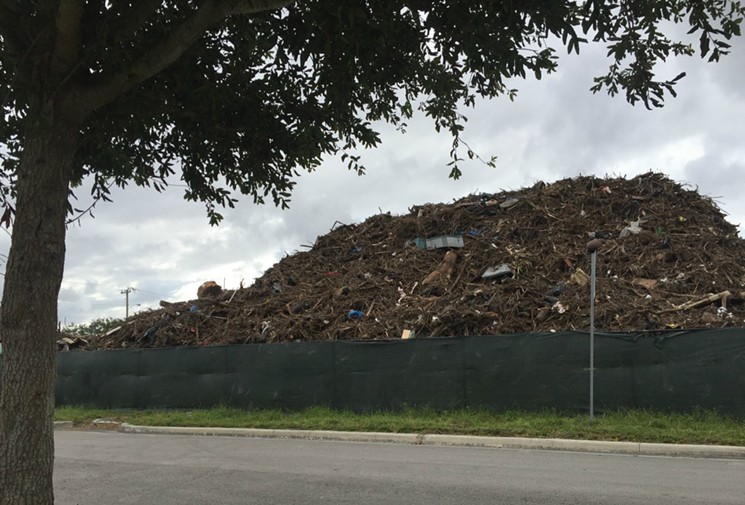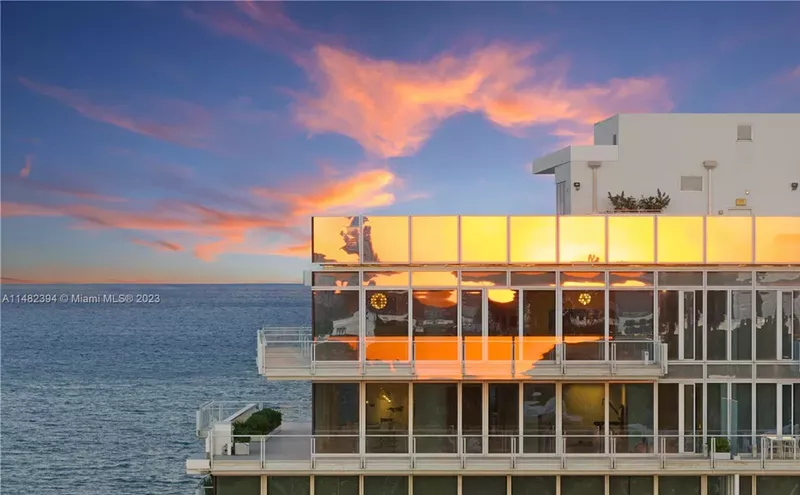Bracing on the rail of her front porch, Brittany Smith exhales hoarsely and covers her mouth. Ten yards away, a dusty cloud hovers above a four-story mountain of shredded tree debris, moldy trash, and musty mattresses. "We've been breathing that in for over a month," the 26-year-old says.
Smith says that for the past few weeks, she's seen a constant stream of garbage trucks dump hurricane debris in the empty lot across the street from her house in Liberty City. Clearing her throat, she says, "Every night, I go to bed watching the fumes and praying they don't let that debris catch fire."
Since late September, Miami-Dade’s waste management department has been dumping millions of tons of Hurricane Irma debris into six approved sites scattered across the county. But Liberty City’s Poinciana Industrial Park outside Smith's home is the only site located in a residential neighborhood. Although the park is county property, many residents have begun protesting the mounting pile of trash outside their homes, claiming it has instigated severe health problems throughout the community.
“It’s because we’re in the inner city that nobody cares,” Smith says. “This would never happen in Pompano or Broward.”
According to Tere Florin, a spokesperson for county’s Department of Regulatory & Economic Resources, hurricane-debris staging sites are selected by local governments based on criteria such as geographic location, size, and ease of access, as required by the Federal Emergency Management Agency (FEMA).
Out of six debris sites in Miami-Dade, three are located in empty lots beside airports, one is next to an existing landfill, and one is inside a largely industrial area. The sixth is Liberty City’s Poinciana Industrial Park, a plot located at NW 75th Street and NW 25th Avenue across from Northpark, a gated residential neighborhood with more than 350 units, including subsidized housing. The mostly black and Hispanic community includes families, children, senior citizens, and people with disabilities.
The problem, Smith says, began soon after Irma had passed through, when she and her neighbors walked out their front doors to see a small mound of trash in the empty lot across the street. At the time, they hadn’t received any notices, so she thought little of it. The next day, though, she woke up in a flurry at 6 a.m. Outside, garbage trucks and backhoes growled, buzzed, and beeped loudly. Though she hoped it was temporary, with each passing day, the mound grew. Soon enough, it had morphed into a mountain of detritus containing putrid mattresses, ripped sofas, plastic tarps, and other junk. For weeks, the site wasn’t cordoned off, she says. Only recently did the county finally erect a protective fence.
“Each time we complained to the rental office, they told us the same thing: It’s [county] property; there’s nothing they can do,” Smith says. “But we can’t even go outside. We’re scared for our health.”
The county insists there’s nothing to worry about. Florin claims the “bulk of the waste being staged at these sites is comprised of trees and vegetative debris... [which] does not directly pose a threat to drinking water [and that] all debris staging sites are closely monitored to help prevent contamination from spills.”
Even so, the county announced that as of this past Wednesday, new hurricane debris would no longer be accepted at Poinciana Industrial Park; however, old, existing debris would remain at the site until it is separated from nonvegetative waste, thoroughly ground, and ready to be transported to a final disposal site, as per FEMA guidelines. That process could take weeks.
Many residents, especially for those with preexisting conditions, say they're concerned about how the debris site might affect their long-term health. In the past few days, residents have told Elizabeth Taveras, a community representative, they’ve experienced migraines and worsened asthma.
“Residents are being forced to wear gas masks and face masks every time they leave their front door, and when they do, they can’t open their eyes,” she says.
Keyon Jackson, a 32-year-old maintenance worker who also lives at Northpark, says the situation has been a huge health concern for him and his family. Over the past week, the father of three says he’s seen a two-foot possum lurk in his front yard, a pack of rats scurry over the fence, and scourges of mosquitoes buzz near his windows. He’s even noticed drain flies enter through a grate in his backyard and come out through the plumbing inside his home.
“My kids used to play and bike outside, but they’ve got sinus problems and allergies like me,” Jackson says. “Now I gotta keep them inside, away from the rats, cockroaches, and dirty air.” He points to a mess of green powder on his doorstep: “I’ve even had to put out rat poison, and even that’s a hazard for my kids.”
Adds Taveras: “We don’t even know what vermin is being produced in that ecosystem.”
But the main concern for many residents is the possibility that their water systems are contaminated. “Especially with the high amounts of rain and flooding we've been facing lately, [a] drain-off of harmful chemicals and toxins [can] definitely directly attack [a] body of water in a negative way,” says Valencia Gunder, an activist for the homeless who lives two minutes from the dumpsite.
She adds, “With that kind of trash sitting in our community for months, we will see some unthinkable things shortly.”
As a safety precaution, many residents have begun drinking only bottled water, a sentiment that closely mirrors the fears of those living in Flint, Michigan, during that city's 2014 water crisis.
“We’re scared of the sink water and the shower water because we don’t know what we’re not seeing,” Jackson says.
Many residents are calling the site an example of “environmental racism,” a term that refers to the decades-long practice of placing toxic sites, such as Superfund sites and landfills, near impoverished, minority communities.
“It’s a chronic issue that low-income communities bear the burden of pollution, waste collection, and other environmental justice issues,” says Rachel Silverstein, executive director at Miami Waterkeeper.
In 2010, another public park in Liberty City — Olinda Park, at NW 51st Street and NW 21st Avenue — was found to contain soil with lead concentrations more than ten times the safe level, as measured by the EPA. Allegedly, the park was once a rock pit where the City of Miami used to dump ash from city garbage incinerators in the late 1930s, until the county turned it into a neighborhood park for Liberty City residents.
“Instead of investing in making black communities habitable, the county chooses to engage in purposeful neglect,” Taveras says. As for the hurricane-debris site, she adds that residents should have been notified when county commissioners were deciding its location. “There was no transparency or communication,” she says.
Smith agrees, adding that the only notice she ever received was a letter sent to her two days ago. In it, Deputy Director Paul Mauriello stated that “the grinding operation [would] continue daily until all of the hurricane debris is removed.” He didn’t specify an estimated date of completion.
In response, Liberty City residents have begun uniting to protest the dumpsite. At the forefront are Northpark neighbors, who announced they, along with the Miami Workers Center and the Community Justice Project, would hold a news conference today at 11 a.m. to demand that county commissioners remove the debris site and that residents be included in determining the timeline.
"Not only should [the county] have told us this was going to happen, but they shouldn't have let it happen in the first place," Smith says.
Disgusted, she turns her back to the pile of festering waste and says, “This isn’t an abandoned area. It's people that live here, and it’s changing the way we live for the worse.”
[
{
"name": "Air - MediumRectangle - Inline Content - Mobile Display Size",
"component": "19274298",
"insertPoint": "2",
"requiredCountToDisplay": "2"
},{
"name": "Editor Picks",
"component": "17482312",
"insertPoint": "4",
"requiredCountToDisplay": "1"
},{
"name": "Inline Links",
"component": "18711090",
"insertPoint": "8th",
"startingPoint": 8,
"requiredCountToDisplay": "7",
"maxInsertions": 25
},{
"name": "Air - MediumRectangle - Combo - Inline Content",
"component": "17482310",
"insertPoint": "8th",
"startingPoint": 8,
"requiredCountToDisplay": "7",
"maxInsertions": 25
},{
"name": "Inline Links",
"component": "18711090",
"insertPoint": "8th",
"startingPoint": 12,
"requiredCountToDisplay": "11",
"maxInsertions": 25
},{
"name": "Air - Leaderboard Tower - Combo - Inline Content",
"component": "17482313",
"insertPoint": "8th",
"startingPoint": 12,
"requiredCountToDisplay": "11",
"maxInsertions": 25
}
]

















